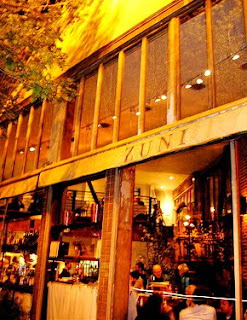 When in Rome, everyone knows, you do as the Romans do – including eat, and drink, and hang around outdoor cafés from early afternoon to the wee hours of the morning.
When in Rome, everyone knows, you do as the Romans do – including eat, and drink, and hang around outdoor cafés from early afternoon to the wee hours of the morning.When in Rome, you drink Frascati. When in Florence, it’s more likely Chianti; in Pamplona, probably Rioja; in Strasbourg, Alsatian riesling or pinot gris; in Nice, Cassis rosé or blanc; or in Paris, Chinon, Saumur-Champigny or Beaujolais. But why? It’s cultural, it’s tried-and-true, and why fight it? Man gotta eat, after all; and as Woody Allen once said (at least about cavemen), “frequently there must be a beverage.”

There is a lot to be said for the natural regional wine and food matches of the world, but also a lot about how global influences wash up on our shores wherever we are. In Hawai`i, for instance, we don’t really make our own wine to write home about, but we do have an enormous range of foodstuffs at our disposal. The Islands are, after all, the “melting pot of the Pacific”; and since this pot is very much multi-cultural and cosmopolitan, so are our choices of wine – from everywhere, with an everywhereness about them. Globally inspired wine and food matches as good as anything in Rome, or anywhere else for that matter.
So if or when you find yourself in the Hawaiian Islands, where the sand is soft as silk and the water as clear and bright as Mother Nature's bathtub...

do keep some of these tried-and-true matches in mind when you order up some of the local delicacies:
• Poke style raw tuna (with soy, sesame oil, sweet Maui onions, fresh chopped seaweed and chili pepper): classic, spicy fruited pinot noirs (from Oregon, California, New Zealand or France); or Austria’s zweigelt or lemberger (the latter, also produced in Washington); sparkling rosés or blanc de noirs.
• Flash seared raw tuna in wasabi mustard sauces: French Champagne; Italian prosecco; or most dry California sparklers; softer styles of pinot noir or most fruit-forward red wine blends (for sampling of the latter, see Basic guidelines to matching the Asian/fusion palate).
 • Lomi lomi salmon (chopped salmon, tomato and green onions): dry yet fruity rosés (Bandol, Tavel, Cassis or Marsannay from France, Rosé di Regaleali from Italy, or California’s SoloRosa); off-dry German rieslings (halbtrocken or QbA); verdejo from Spain; or Portugal’s Vinho Verde.
• Lomi lomi salmon (chopped salmon, tomato and green onions): dry yet fruity rosés (Bandol, Tavel, Cassis or Marsannay from France, Rosé di Regaleali from Italy, or California’s SoloRosa); off-dry German rieslings (halbtrocken or QbA); verdejo from Spain; or Portugal’s Vinho Verde.• Spam Musubi & Sushi (most varieties): dry rosé (Southern French, or most any dry California pink made from grapes like grenache, barbera or pinot noir); France’s Beaujolais (especially grand crus like Morgon, Fleurie or Moulin-à-Vent); sparkling shiraz from Australia; or softer, moderately priced pinot noirs (Oregon, California, or Austria).
• Huli-huli chicken (rock salted and charcoal grilled halves): almost any good California or Australian chardonnay; pinot gris from Oregon, Alsace, Austria or New Zealand; new style, fluid, mildly crisp California varietals such as grenache blanc, vermentino or verdelho.
• Kalua pig (roasted, smoke flavored, rock salted pork): more intense, off-dry German rieslings (especially kabinett); deeply fruited, smoky oaked California zinfandel or petite sirah (especially from Lodi or Sonoma's Dry Creek Valley or Rockpile AVA); or from Spain, tempranillo (like Cigales, Rioja, or La Mancha) or garnacha based reds (Montsant or Priorat).
• Hawaiian beef stew (i.e. pipi stew; tomatoes, potatoes, carrots, celery and onions): soft, velvety merlots (California, Chile or Italy); richer Spanish reds (reserva bottlings from Rioja, Ribera del Duero, Priorat, or Mencía); silkier styles of sangiovese (especially Chianti, Carmignano, Rosso di Montalcino or Vino Nobile di Montepulciano); cabernet franc based reds like Bourgueil, Chinon or Cahors from France.
 • Mahimahi (dolphinfish) in lemon butter sauces: Austria’s grüner veltliner; creamier textured (i.e. lightly oaked) California sauvignon (a.k.a. fumé) blanc; lighter, crisper, minerally style chardonnays (from Mendocino or Santa Barbara, Oregon, Washington, or Mâcon in France); or Italian whites made like Arneis, Gavi or Greco.
• Mahimahi (dolphinfish) in lemon butter sauces: Austria’s grüner veltliner; creamier textured (i.e. lightly oaked) California sauvignon (a.k.a. fumé) blanc; lighter, crisper, minerally style chardonnays (from Mendocino or Santa Barbara, Oregon, Washington, or Mâcon in France); or Italian whites made like Arneis, Gavi or Greco.• Miso butterfish (marinated black cod): dry style rieslings (Alsatian, German trocken, and dry styles from California or Australia); Spain’s albariño; most dry French champagne or méthode Champenoise style sparklers from California; most ginjo sakés.
• Chicken katsu (panko crusted) or grilled salmon with ponzu dips: crisp-edged sauvignon blanc (especially Sancerre or Pouilly-Fumé from France); France’s Picpoul, Muscadet, Montlouis or Savennières; Italy’s friulano or pinot grigio; torrontés from Argentina.
• Korean style short ribs of beef (i.e. kalbi; soy/garlic/ sugar/sesame seed marinades): spicy, aromatic Australian shiraz or cabernet/shiraz blends; California, Washington or Southern Oregon syrahs; or else California zinfandels or syrahs (bigger the better).
• Teriyaki beef or pork (sweet soy/ginger marinades): richer, ultra-premium pinot noirs (California or Oregon); rounder, softer cabernet sauvignon or Bordeaux style blends (Australia, Chile, or low to medium priced Californians); zesty, fruit forward carignane or the most food-versatile California red of all, zinfandel.
Surf's up!











Comments
Post a Comment